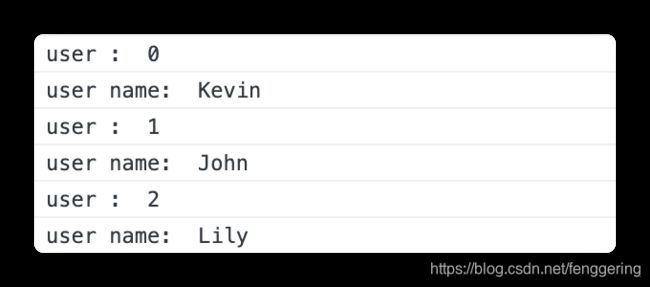前端:JS的数组的遍历、map、filter、find、some、every的用法示例
目录
一、最基本的遍历写法:
二、forEach遍历:
三、for of 遍历
四、for in 遍历
五、map 根据原数组产生新数组
六、filter 对数组元素进行筛选
七、find 查找符合条件的第一个元素
八、some 判断是否存在元素符合条件
九、every判断是否所有元素都符合条件
在JS语法里,如果想要遍历一个列表(数组),比如下面这个userList:
const userList = [
{
id: 1,
name: "Kevin",
age: 10,
subject: 5,
state: 1,
},{
id: 2,
name: "John",
age: 15,
subject: 1,
state: 0,
},{
id: 3,
name: "Lily",
age: 20,
subject: 2,
state: 1,
}
]想遍历userList,打印每个元素的name值,
一、最基本的遍历写法:
for (let i = 0; i < userList.length; i++) {
const user = userList[i];
console.log("user name: ", user.name);
}这种写法最常见也容易理解,运行结果如下。
二、forEach遍历:
userList.forEach(function(user) {
console.log("user name: ", user.name);
})这个forEach方法传入一个function,userList有几个元素,这个function就会被调用几次,它的入参user就是遍历userList时依次拿到的元素。
实际上forEach的语法如下:
array.forEach(function(value, index, arr), thisValue)
value:必须,代表当前元素,其他参数都是可选,index代表当前索引值,arr代表当前的数组,thisValue代表传递给函数的值,一般用this值,如果这个参数为空,undefined会传递给this值。
function: 用来对元素进行处理,无返回值。
返回值:undefined
我们可以用箭头语法简化一下上面这个forEach代码,改成这样:
userList.forEach(user => console.log("user name: ", user.name))另外需要注意:forEach中不能使用break、continue和return语句,也就意味着用forEach的话遍历完所有的元素才结束。
三、for of 遍历
for...of 用于遍历数组的元素,还可以遍历字符串,Map,Set等。
比如用for...of遍历userList:
for(const user of userList) {
console.log("user name : ", user.name)
}运行结果:
四、for in 遍历
for...in 语句用于遍历数组或者对象的属性。
用for...in遍历userList:
for (const i in userList) {
console.log("user : ", i);
console.log("user name: ", userList[i].name);
}注意如果遍历的是数组for in中这里的 i 就是下标。运行结果如下。
而如果用for in遍历对象各个属性,这里的 i 就是属性名。如下:
const usr = userList[0];
for(const i in usr) {
console.log("user attr : ", i);
console.log("user attr value : ", usr[i]);
}运行结果:
四种遍历中,普通for循环是效率最高的,而for...in循环最慢。
五、map 根据原数组产生新数组
map用于遍历数组,对数组中的各个元素做处理。
语法:array.map(function(value, index, arr), thisValue)
value:必须,代表当前元素,其他参数都是可选,index代表当前索引值,arr代表当前的数组,thisValue代表传递给函数的值,一般用this值,如果这个参数为空,undefined会传递给this值。
function:表示获取新元素的函数,返回值为新元素。
返回值:返回一个新数组,数组中的元素为原始数组元素调用函数处理后的值。
对userList遍历并且对各个元素的age加1,得到新的数组newList的示例:
const newList = userList.map(user => {
return {
id: user.id,
name: user.name,
age: user.age + 1,
subject: user.subject,
state: user.state,
}
});用forEach 打印原数组和新数组:
userList.forEach(user => console.log("user age : " + user.name + " : " + user.age));
console.log("------------------")
newList.forEach(user => console.log("user age : " + user.name + " : " + user.age));运行结果:
这里提一下forEach和map都可以遍历数组并且依次对数组元素进行处理。区别是:
array.forEach没有返回值,且传入的function也没有返回值。只是对数组元素做处理,处理完后原数组改变。
而array.map的返回值是一个新的数组,传入的function也有返回值(需返回新的元素),处理完后原数组不变。
因此如果不想改变原数组的话,就可以使用map进行遍历,生成一个新数组。
六、filter 对数组元素进行筛选
filter用于按指定条件筛选元素,产生新的数组。
语法: array.filter(function(value, index, arr), thisValue)
value:必须,代表当前元素,其他参数都是可选,index代表当前索引值,arr代表当前的数组,thisValue代表传递给函数的值,一般用this值,如果这个参数为空,undefined会传递给this值。
function: 用于筛选元素,返回值为布尔值,返回true则此元素被放入新数组。
返回值:返回数组,包含了符合条件的所有元素,如果没有符合条件的则返回空数组。
比如使用filter筛选出userList里state为1 的元素:
const newList = userList.filter(user => user.state == 1);有些人可能会问,filter传入的function不是有返回值的吗,怎么这里没有return?
其实这里是用了lambda表达式简化了写法,用return的话可以这么写:
const newList = userList.filter(user => {return user.state == 1});得到的newList就只包含了state为1的两个元素。用forEach打印newList看看:
newList.forEach(usr => console.log("user name : ", usr.name));运行结果:
七、find 查找符合条件的第一个元素
find用来遍历数组,查找符合条件的元素,在查找到符合条件的第一个元素后就会返回。
语法: array.find(function(value, index, arr), thisValue)
value:必须,代表当前元素,其他参数都是可选,index代表当前索引值,arr代表当前的数组,thisValue代表传递给函数的值,一般用this值,如果这个参数为空,undefined会传递给this值。function: 用来查找符合要求的元素的函数。返回值为布尔值。
返回值:返回符合测试条件的第一个数组元素的值,如果没有符合条件的则返回undefined。
比如在userList中查找age大于10的元素:
const result = userList.find(user => user.age > 10);
console.log("user : ", result.name);John和Lily的age都大于10,但是返回都result只有John。因为find只要找到一个符合条件的元素就不会再继续遍历了。运行结果如下:
八、some 判断是否存在元素符合条件
some遍历数组,依次判断每个元素,如果存在某个元素符合条件,则返回true;没有元素符合条件则返回false。
语法: array.some(function(value, index, arr), thisValue)
value:必须,代表当前元素,其他参数都是可选,index代表当前索引值,arr代表当前的数组,thisValue代表传递给函数的值,一般用this值,如果这个参数为空,undefined会传递给this值。function: 用来判断元素是否满足要求。返回值为布尔值。
返回值:如果存在某个元素符合条件,则返回true;没有元素符合条件则返回false。
比如判断userList是否存在name为Lily的元素:
const result = userList.some(usr => usr.name == "Lily");
console.log("result == ", result);运行结果:result == true
九、every判断是否所有元素都符合条件
every遍历数组,依次判断每个元素,如果每个元素都符合条件则返回true;任意一个不符合条件则返回false。
语法: array.every(function(value, index, arr), thisValue)
value:必须,代表当前元素,其他参数都是可选,index代表当前索引值,arr代表当前的数组,thisValue代表传递给函数的值,一般用this值,如果这个参数为空,undefined会传递给this值。function: 用来判断元素是否满足要求。返回值为布尔值。
返回值:如果每个元素都符合条件则返回true;任意一个不符合条件则返回false。
比如判断是否userList里的每个元素name都为Lily:
const result = userList.every(usr => usr.name == "Lily");
console.log("result == ", result);运行结果:result == false






